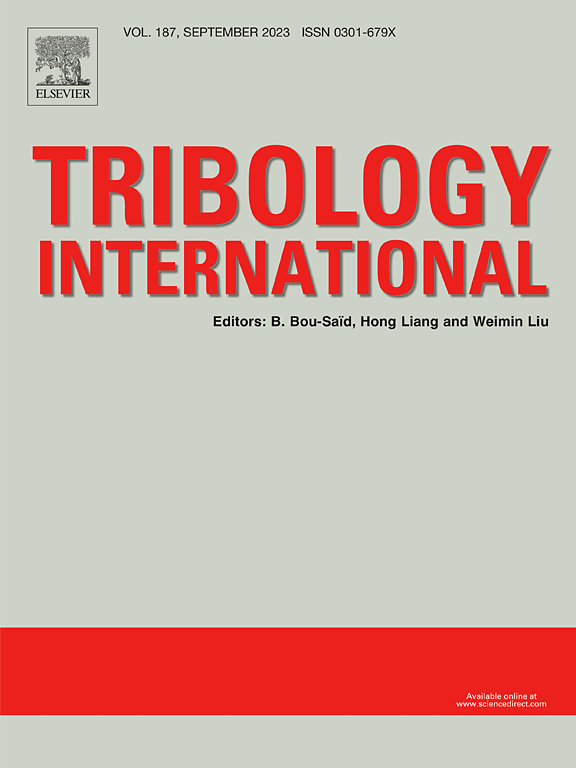采用纳米刻划实验和分子动力学模拟研究不同刻划速度下4H-SiC去除机理
IF 6.1
1区 工程技术
Q1 ENGINEERING, MECHANICAL
引用次数: 0
摘要
碳化硅(SiC)作为第三代宽禁带半导体的代表,具有优异的热学、电学和力学性能,广泛应用于大功率电子、可再生能源系统、光电等领域。但其固有的高硬度和脆性会在超精密磨削过程中造成亚表面损伤,影响制造成本和设备可靠性。为了研究刮擦速度对4H-SiC材料去除和亚表面损伤的影响,采用原子力显微镜(AFM)刮擦和分子动力学(MD)模拟相结合的方法。实验结果表明,较高的刮擦速度显著降低了摩擦力,减少了晶体缺陷,从而减少了对亚表面结构的破坏。MD模拟进一步表明,划痕速度对亚表面损伤的演化有很大影响。在较低的速度下,较长的接触时间促进位错滑移和扩展,形成更深的损伤层。相比之下,在较高的速度下,塑性变形不太发达,损伤仅限于近表面区域。此外,发现von Mises应力的空间分布与位错演化密切相关,表明应力驱动机制在地下损伤形成中起关键作用。该研究为进一步了解4H-SiC的纳米损伤机理提供了新的思路,为其高效、低损伤加工提供了理论指导。本文章由计算机程序翻译,如有差异,请以英文原文为准。
Mechanistic study of 4H-SiC removal under various scratching speeds using nano-scratching experiments and molecular dynamics simulations
Silicon carbide (SiC), as a representative third-generation wide-bandgap semiconductor, exhibits excellent thermal, electrical, and mechanical properties, making it widely used in high-power electronics, renewable energy systems, and optoelectronic applications. While its inherent high hardness and brittleness lead to subsurface damage during ultra-precision grinding, affecting both manufacturing cost and device reliability. To investigate how scratching speed affects material removal and subsurface damage in 4H-SiC, a combined approach utilizing atomic force microscopy (AFM) scratching and molecular dynamics (MD) simulations was employed. Experimental results revealed that higher scratching speeds significantly decreased friction forces and reduced crystal defects, leading to a less damaged subsurface structure. MD simulations further revealed that scratching speed strongly influences the evolution of subsurface damage. At lower speeds, longer contact durations promote dislocation slip and propagation, forming deeper damage layers. In contrast, at higher speeds, plastic deformation is less developed and the damage is confined to near-surface regions. Additionally, the spatial distribution of von Mises stress was found to correlate closely with dislocation evolution, indicating that stress-driven mechanisms play a critical role in subsurface damage formation. This study provides new insights into the nanoscale damage mechanisms of 4H-SiC and offers theoretical guidance for its high-efficiency, low-damage machining.
求助全文
通过发布文献求助,成功后即可免费获取论文全文。
去求助
来源期刊

Tribology International
工程技术-工程:机械
CiteScore
10.10
自引率
16.10%
发文量
627
审稿时长
35 days
期刊介绍:
Tribology is the science of rubbing surfaces and contributes to every facet of our everyday life, from live cell friction to engine lubrication and seismology. As such tribology is truly multidisciplinary and this extraordinary breadth of scientific interest is reflected in the scope of Tribology International.
Tribology International seeks to publish original research papers of the highest scientific quality to provide an archival resource for scientists from all backgrounds. Written contributions are invited reporting experimental and modelling studies both in established areas of tribology and emerging fields. Scientific topics include the physics or chemistry of tribo-surfaces, bio-tribology, surface engineering and materials, contact mechanics, nano-tribology, lubricants and hydrodynamic lubrication.
 求助内容:
求助内容: 应助结果提醒方式:
应助结果提醒方式:


